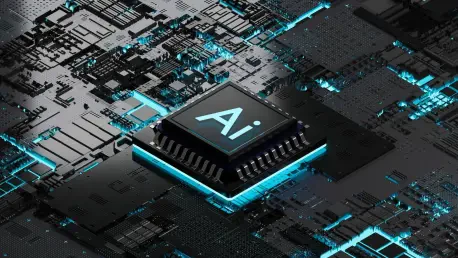In today’s rapidly advancing technological landscape, artificial intelligence (AI) has grown from a theoretical concept to a key driver of innovation across various industries. Businesses and developers are increasingly relying on AI tools and frameworks to improve efficiency, automate tasks, and enable predictive analytics. As these technologies evolve, their versatility and scalability become invaluable, offering solutions that cater to a range of applications—from deep learning and classical machine learning to specialized AI needs like computer vision and conversational intelligence.
Pioneers in Deep Learning
TensorFlow: The Scalable Giant
TensorFlow, a creation of the Google Brain Team, offers unparalleled scalability in developing deep learning models. Its ecosystem, featuring components like TensorBoard for visualization, TensorFlow Lite for mobile and embedded applications, and TensorFlow.js for in-browser processing, underscores its versatility across various AI tasks. TensorFlow addresses image recognition, natural language processing, and speech recognition, making it a formidable choice for diverse AI applications. The platform is engineered for production-level scalability, enabling developers to seamlessly transition from prototypes to large-scale deployments. Notably, TensorFlow’s community provides extensive resources and support, further enhancing its appeal in the tech industry.
PyTorch: The Researchers’ Choice
PyTorch, developed by Facebook’s AI Research Lab, has rapidly become the go-to framework for researchers due to its dynamic computation graph and extensive Pythonic interface. This flexibility allows for iterative development and supports a wide range of AI applications, from basic neural networks to more complex computer vision projects. PyTorch offers seamless integration with Open Neural Network Exchange (ONNX), making transitions from experimentation to deployment smoother. Additionally, its robust GPU acceleration capabilities ensure efficient processing for demanding tasks. The framework’s popularity in the academic community has spurred a wealth of libraries, tutorials, and research papers, contributing to its growth and reliability.
Foundations of Classical Machine Learning
Scikit-learn: Simplicity and Power
Scikit-learn stands out in the realm of classical machine learning due to its ease of use and powerful capabilities. It provides essential tools for tasks like classification, regression, and clustering and integrates seamlessly with established Python libraries such as SciPy, NumPy, and Matplotlib. This integration facilitates the implementation and interpretation of models, enabling data scientists to focus on results rather than complex coding. Scikit-learn’s simplicity makes it accessible to both novice and experienced users, fostering innovation and advancing projects within the data science community. Its consistent updates ensure relevance with current methodologies, cementing its position as a staple in machine learning development.
##O.ai: Automated Solutions for Enterprises
##O.ai distinguishes itself with automated machine learning capabilities tailored for enterprise applications across industries like finance and healthcare. Its platform offers AutoML, democratizing AI by enabling users without programming expertise to create sophisticated models. ##O.ai supports multiple programming languages, facilitating integration into existing systems and promoting adaptability in diverse environments. The framework’s user-friendly design and focus on business applications make it ideal for companies seeking to enhance decision-making processes. Its ability to scale and support large datasets ensures enterprise-level performance and delivers actionable insights crucial for competitive advantage within rapidly changing markets.
Innovators in Specialized AI Applications
OpenCV: Visionary Capabilities
OpenCV excels as a comprehensive tool for real-time computer vision applications, supporting an extensive range of languages to cater to diverse developer needs. Its capabilities include image processing, facial recognition, and motion detection, bolstered by additional GPU acceleration to optimize performance. OpenCV serves as the backbone for innovative projects ranging from autonomous vehicles to interactive entertainment. By offering robust and efficient image processing functions, it has positioned itself as an essential resource for developers focusing on visual technologies. The framework’s long-standing presence and continuous updates ensure it remains pivotal in visual intelligence implementations.
IBM Watson: Conversational AI Expert
IBM Watson’s suite of APIs equips developers with the tools required to create sophisticated conversational AI and enterprise solutions. With strong integration with IBM Cloud, Watson focuses on natural language processing, visual recognition, and machine learning, ensuring secure and efficient deployments. Watson’s formidable capabilities in handling customer interactions and data analysis have cemented its role in enhancing customer service, driving engagement and satisfaction. These attributes, combined with IBM’s dedication to privacy and data protection, have made Watson a preferred choice for both small-scale implementations and expansive enterprise projects, expanding its reach across industries.
Industry Game-Changers
Keras and Ease of Experimentation
Keras, functioning atop TensorFlow and PyTorch, provides developers with a simple yet powerful neural network API designed for rapid experimentation and prototyping. Its intuitive interface makes it a perfect entry point for beginners while also offering significant advantages to seasoned developers seeking streamlined workflows. Keras supports a range of models, from simple prototypes to complex architectures, facilitating swift transitions from conception to testing stages. Additionally, it nurtures a collaborative environment through community-driven resources and development efforts, making it a key player in projects demanding quick innovation and iterative exploration.
Apache MXNet and Edge Nutriment
Apache MXNet offers remarkable scalability and performance, particularly suited for edge devices and mobile applications. Supported by Amazon Web Services, MXNet operates across multiple programming languages, providing flexibility and comprehensive support for a wide range of tasks. Its hybrid programming model is optimized for deployment in environments where quick response times are crucial and computational resources are limited. This makes MXNet ideal for developers focusing on cutting-edge solutions that require real-time data processing, ensuring efficiency in both centralized and distributed systems, significantly enhancing the breadth of applications it can support.
Democratizing AI for All Skill Levels
Microsoft Cognitive Toolkit: Performance at Scale
The Microsoft Cognitive Toolkit (CNTK) focuses on delivering high-performance model training, empowering developers with parallel GPU support for extensive, large-scale applications. Its integration within Microsoft’s extensive product ecosystem ensures seamless collaboration and optimized development paths. CNTK’s design caters to projects demanding scalable solutions and robust training environments, thereby enhancing performance and productivity. By focusing on efficient resource allocation and comprehensive toolkits, CNTK ensures developers can engage with complex AI challenges without compromising on speed or scalability, positioning itself as a pivotal tool for advancing AI innovation on a global scale.
RapidMiner: Accessible Intelligence
In the swiftly evolving realm of technology, artificial intelligence (AI) has transformed from an abstract notion to a pivotal force driving innovation across diverse sectors. Today, businesses and developers are increasingly leveraging AI tools and frameworks to boost efficiency, automate repetitive tasks, and facilitate predictive analytics, which helps anticipate trends and outcomes. As AI technologies advance, they become fundamentally versatile and scalable, offering invaluable solutions to meet varied applications. From deep learning, where AI models learn to recognize patterns, to classical machine learning that analyzes data to make decisions, these technologies are instrumental. They also address specialized AI demands like computer vision, which enables machines to interpret visual data, and conversational intelligence, which enhances human-machine interactions through natural language processing. AI’s evolution continually opens new avenues for innovation, positioning it as a cornerstone in technological progress and industry transformation.








